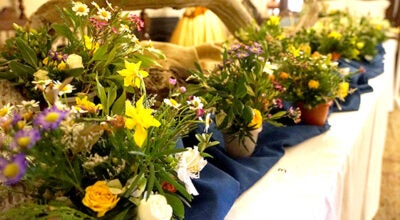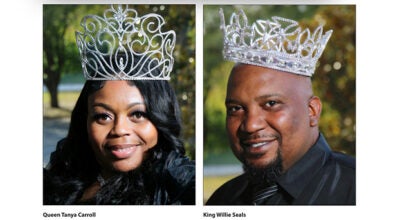READ LOCAL: Natchez historian authors book; Natchez Trace subject of one
Published 12:00 am Wednesday, July 18, 2012

Jim Barnett, director of the Grand Village of the Natchez Indians, authored “Mississippi’s American Indians,” which was recently published. Barnett is pictured with his book, which was published by the University of Mississippi Press, outside an Indian hut at Grand Village.
NATCHEZ — When Christopher Columbus sailed the ocean blue, his presence did more than forge a rhyme on which future generations of Americans would hang their history.
That journey forever influenced the culture of American Indians, director of Grand Village of the Natchez Indians Jim Barnett said. And it did so nearly in an instant.
It wasn’t just the diseases, like smallpox that spread, but the culture and economy the Europeans brought with them that altered the native society, he said.
“(European culture) completely disturbed whatever equilibrium they had,” Barnett said.
For more than 30 years, Barnett has worked as director of the Grand Village.
A history buff since childhood, Barnett recently authored a book titled “Mississippi’s American Indians,” which he started writing in 2007.
The book, published by the University of Mississippi Press, is part of the Heritage of Mississippi Series — a project by the Mississippi Department of Archives and History, the University Press and the Mississippi Historical Society and designed to coincide with 2017 bicentennial of Mississippi’s statehood.
Barnett said the transformation of the American Indian culture as a result of contact with Europeans interested him most.
With the entrance of European goods like metal tools, cooking materials, blankets and clothing, a new currency was established. And the only trading items Europeans valued from American Indians were deerskins and human slaves.
“One of the most destructive things was Indian slave trade,” Barnett said.
Indians would raid neighboring tribes for the slave trade in order to attain European goods. The result was heavily damaged relationships between the tribes.
Another change that resulted in the European culture influences was to the social structure, Barnett said.
The most glaring evidence of this is the sudden halting of mound building, Barnett said.
“Mound building went out of people’s lives it seems almost overnight,” Barnett said.
Barnett said his conclusion about the reduction of mound building rests in the influence of the European economy.
Before, American Indians were born into an elite social class, and members of the lineage constituted the chiefs, for example.
Once goods were traded, the most enterprising individual — not necessarily those born into an elite lineage — had a higher social status.
“Mound building had a lot to do with paying tribute to these elite chiefs,” Barnett said.
“(But) as soon as Columbus set sail for this part of the world, it stopped,” said Barnett as he snapped his fingers.
Hernando De Soto found records of mound building in the 1540s, Barnett said. But by the time Robert de La Salle explored the same area, and as early as the 1830s, “it was a very changed situation,” Barnett said.
The American Indians’ outward appearance was similar to the settlers.
“By that time there was an attempt to assimilate. (American Indians) were wearing clothes, living in long cabins, plowing with mules and raising (animals),” Barnett said.
The last chapter of “Mississippi’s American Indians” discusses the treaties that essentially removed the majority of the American Indians from the area. Today only the Mississippi Band of Choctaw still reside in the area, down from 20 tribes at the beginning of the 1700s.
“The main lesson to learn (from the book) is that in the formation of our country, some pretty terrible things happened to native people who lived here,” Barnett said.
Barnett said Mississippians should understand how a native people controlled the place where they live at one time.
“But they aren’t here anymore,” he said.
Now in most cases, only the mounds exist as a historic and tourist attractions, like those outside Barnett’s office.
Fore more information about “Mississippi’s American Indians,” visit www.upress.state.ms.us/books/1472.
In addition to local author Barnett’s success, another member of the Natchez community was recently honored on the pages of a book — the Natchez Trace.
“Building the Natchez Trace”
Natchez Trace Parkway Association President Tony L. Turnbow said the association authored the book to honor the 75th anniversary of the Natchez Trace Parkway.
The book is told mostly through old photographs, he said..
“Building the Natchez Trace” illustrates how a small group of people in the South in the 1930s convinced the federal government to build a three-state federal park, Turnbow said.
“They continued to push for it even when there seemed to be insurmountable obstacles,” he said, citing the Great Depression and World War II as an example.
One of oldest trails in North America, some theorize that animals and early peoples used the Trace in order to get from one point to another to the Mississippi River.
It was used in the War of 1812, and Andrew Jackson first marched troops down the Trace 1813 and again in 1814, Turnbow said.
But by the early 1900s, it was fading from public memory, the book’s introduction explains.
The Mississippi group of the Daughters of the American Revolution wanted to preserve the road, so they placed the first marker in Natchez in 1909 near the bluff.
Among some of the major players was a woman from Natchez who lived in a house with a name.
The chapter called Moonshine and Meatloaf tells the story of Roane Fleming Byrnes, who entertained state and national politicians and influential magazine editors at her home, Ravennaside.
Turnbow said Byrnes charmed many of the officials and won their support for her cause, which she worked toward until her death in the 1970s.
Byrnes would invite officials to dinner and show them her “war room,” which contained pictures and maps of the future parkway drawn up by artists.
“She gave (officials) her vision while they were there,” Turnbow said.
Turnbow said the association still has a passionate group of people who plans to incorporate more sites along the parkway that will help it fit into the scope of national parks.
For more information about “Building the Natchez Trace,” visist www.arcadiapublishing or call 888-313-2665.





